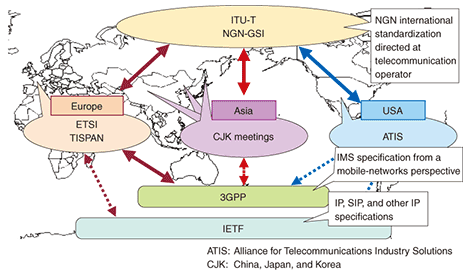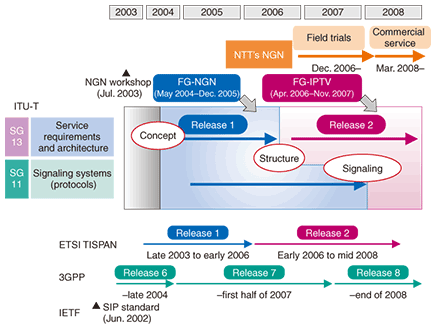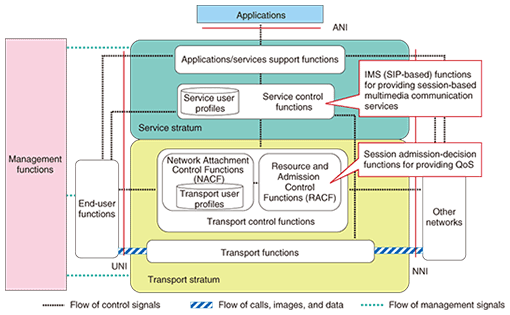 |
|||||||||||||||
|
|
|||||||||||||||
|
Special Feature: NGN Focus Vol. 7, No. 7, pp. 8–11, July 2009. https://doi.org/10.53829/ntr200907sf3 Standardization Trends of NGN TechnologiesAbstractThis article outlines the history of Next Generation Network (NGN) standardization activities and plans for the future. International standardization of the NGN has been the subject of ongoing studies with the aim of using flexible and economical Internet protocol (IP) technologies to ensure the quality and stability essential to a communications business, to converge fixed-line & mobile communications and telecommunications & broadcasting, and to establish a communications infrastructure as a foundation for information technology services.
1. History of NGN studies at ITU-TInternational standardization of technologies for the Next Generation Network (NGN) dates back to the NGN workshop held by ITU-T (International Telecommunication Union, Telecommunication Standardization Sector) in July 2003 [1]. At that time, NTT was already presenting the current NGN concept of providing safe and secure multimedia services using Internet protocol (IP) technology. This workshop was followed by the launch in Europe of the European Telecommunication Standards Institute, Telecoms & Internet converged Services & Protocols for Advanced Network (ETSI TISPAN) project in September 2003, where studies began on a next-generation telecommunications infrastructure that would apply the IP Multimedia Subsystem (IMS) specified by the 3rd Generation Partnership Project (3GPP) to high-speed, broadband access. Initial specifications were completed in early 2006 and designated “NGN Release 1” [2]. IMS clarifies the application of the session initiation protocol (SIP) specified by the Internet Engineering Task Force (IETF) from the viewpoint of mobile telecommunication operators. Thus, NGN standardization has been progressing through the interaction and cooperation of various standardization bodies around the world (Fig. 1).
ITU-T, which establishes international standards (Recommendations) for telecommunication operators, went on to form the Focus Group on Next Generation Networks (FGNGN) as a special time-limited team for studying NGN issues, and it was the FGNGN’s work that led to the adoption of IMS while taking into account compatibility with existing devices such as software switches. Study Group 13 (SG13), the lead group for NGN studies, initiated a Recommendations procedure in July 2006 and clarified the basic structure and functions of the network that should be achieved through NGN Release 1 [3]. Then, to maintain a centralized NGN study system following the termination of FGNGN, the Next Generation Network Global Standards Initiative (NGN-GSI) was formed from various study groups, such as SG11 for signaling systems, SG19 for mobile networks, and SG17 for security, and regular meetings were held. These NGN standardization activities are summarized in Fig. 2.
2. NGN Recommendations systemIn issuing NGN-related recommendations, ITU-T takes a release approach whereby specific functions are issued together and assigned an estimated completion date with the aim of meeting market needs in an incremental manner. Recommendations dealing with the requirements and architecture that must be satisfied by the NGN are assigned Y.2000 numbers and those dealing with main signaling systems are assigned Q.3000 numbers. All of these recommendations can now be accessed from the ITU website. Main signaling systems were completed at the January 2008 ITU-T meeting, which meant that NGN Release 1 was essentially complete [4]. 3. Services envisioned by NGN Release 1The scope document for NGN Release 1 that prescribes the range of NGN studies describes many services with an eye to future possibilities, but the ultimate objective is essentially to achieve interactive multimedia communication services by voice and images between two parties (session-based services). 4. NGN structureThe capabilities required of the NGN and the arrangement of functions for achieving those capabilities can be specified in the form of a functional architecture (Fig. 3). Conceptually, the NGN consists of a service stratum that implements communication services such as user authentication and registration, party discovery, call-conditions negotiation, and various additional services for supporting and reinforcing those functions, and a transport stratum that transmits IP packets on an end-to-end basis and ensures quality of service (QoS) and security. The integration of these two functional groups achieves NGN communication services.
The connection points between the NGN and the outside are specified as the User Network Interface (UNI) that connects to terminals, the Network Network Interface (NNI) that connects to other NGN operators, and the Application Network Interface (ANI) that connects with applications. For ANI, only a functional model has been given so far in Recommendation Y.2012, but more detailed specifications will be discussed in the future. As for security, which is a special feature of the NGN, requirements that affect network design policies are being specified [5]. 5. Release 2 studiesStudies on NGN Release 2, which began in earnest in November 2006, have been focusing on streaming services like Internet protocol television (IPTV) and mobility extensions to achieve interruption-free communications even when the user changes access network. For IPTV, a focus group called FG-IPTV has been established, building upon the success of FGNGN. In addition to ITU members, about 200 representatives from terminal and device manufacturers, electrical appliance manufacturers, and broadcasting companies have been participating in FG-IPTV meetings, and 20 documents have been prepared (as of the end of 2007). These documents have been placed under the control of the SGs in question, and as of June 2008, four of them have been used for drafting recommendations [6]. 6. Concluding remarksNGN Release 1 envisions session-based communications while NGN Release 2 aims for the provision of IPTV and genuine mobility. Looking forward, NTT Laboratories plans to be an active contributor to international standardization of NGN technologies making use of NTT’s extensive experience and pioneering achievements in Japan’s broadband environment. References
|
|||||||||||||||












